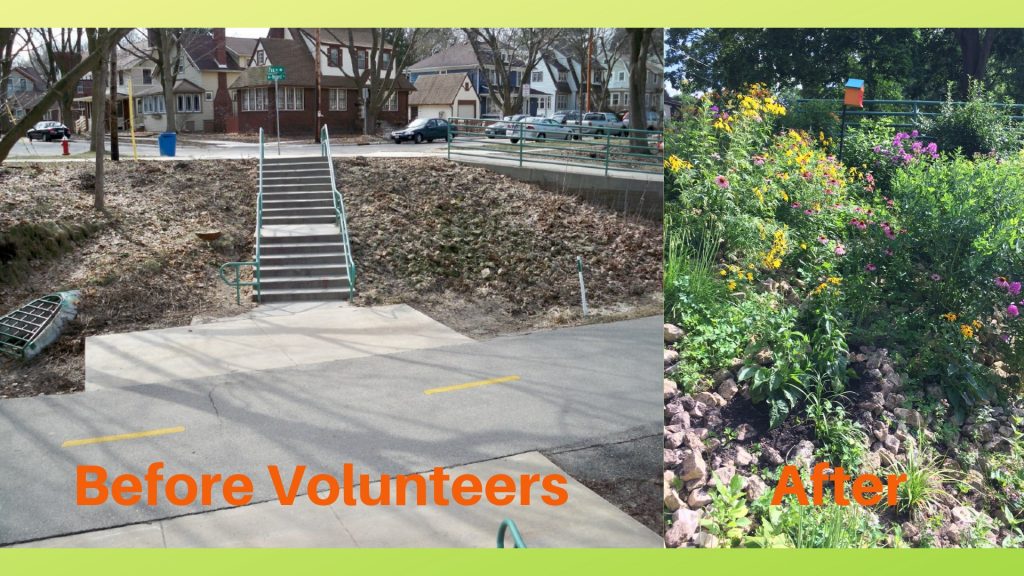In the right season joggers, bikers, walkers, other self-locomotors, and even animals enjoy bright displays of native plants along the Southwest Path. Many undoubtedly enjoy the scenery and take it for granted. The Southwest Path did not always have these gorgeous views and prairies!
Since 2001 volunteers have passionately transformed these weed beds into beautiful and bright native prairies for passersby and users to appreciate and enjoy. Can you imagine what the path would look like without them? It’s a real threat, recruiting the future generation of volunteers is difficult. If you want to volunteer or have thoughts on how to overcome this challenge share them in this survey.
Midvale Heights Prairie and Natural Areas (Midvale to Beltline Hwy, includes Hammersley Connector area) : Spaces full of Bee Balm, Purple Cones, and tall cup plants will attract your eyes. This include areas bordering the West end of the Southwest Path near the Hammersely Connector. The prairie surrounding the Connector and the bike bridge provides a natural contrast to the nearby busy beltline. Over the years the “big ditch” in this area has developed wet tolerant grasses and serves as a habitat to insects and birds borders Hammersely and provides a natural contrast to the nearby beltline. Over the years the “big ditch” in the area has developed wet tolerant glasses and serves as a habitat to insects.
Dudgeon Monroe Prairie: Some consider this site the crown jewel because of its diversity and size. It spans almost 7,000 sq ft and was originally the staging area to construct the bike path. Despite this, today the plants thrive! Much of the seed in this prairie came from Audubon’s Goose Pond in Arlington and Pleasant Valley near Black Earth. In late summer and early fall Monarch butterflies are abundant as generations make their way south and eventually to West Coast of California or mountainous sites in Central Mexico. A few years ago families gathered to watch the release of 100s of Monarchs grown by a local enthusiast.
Glenway Gulch: The Westmorland Greenspace Crew restored a half-acre ravine near Glenway. The crew has successfully conquered invasive species like garlic mustard, and Japanese hedge parsley. Volunteers put up a good fight and now colorful native blooming plants and grasses thrive!
Glenway Prairie & Wildflower Area: Bordering the north side of the Glenway Golf Course and an area across the Path, this site encompasses almost 4,000 sq ft of short grasses, native ornamental plans, shrubs, and wildflowers. A delightful splash of color brightens the intersection inviting passersby to stop, pause and enjoy nature.
Regent Neighborhood Pollinator Garden: Started in 2014, this newest 1,200 sq ft of prairie fills up a triangle shaped area at the Commonwealth Intersection with the Path. Over 60 different species of native plants beautify a once underutilized neighborhood space. Specially designed stone and wood benches invite passersby to sit for a spell and enjoy the breeze, the colors, the birds and butterflies.
Prospect Gardens: A mixture of prairie plants and perennials cover 6,800 sq. ft. around the Prospect and Fox Avenue ramps to the Path. Ruby red raspberries when in season attracts families, grandparents and their grandchildren. Two cherry trees feed both birds and humans. Colorful birdhouses made by a neighbor and his son welcome birds. Goldfinches, in late summer, feast on the dried Purple Cone flowers while Monarch Butterflies flutter by. The Dudgeon-Monroe Neighborhood and the Regent Neighborhood Associations jointly sponsor this site.
To learn more about each of the gardens, check out this blog post from one of the dedicated volunteers!
https://gardensprospect.blogspot.com/2018/07/tour-of-five-gardens-one-vast-garden.html
Photos provided by Jake Blasczyk

